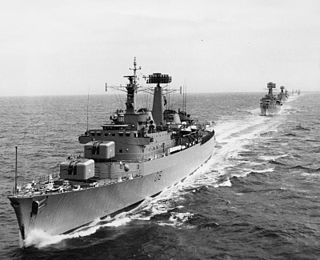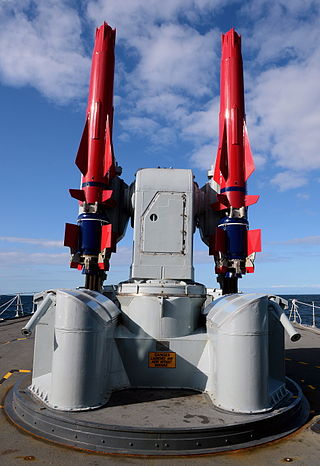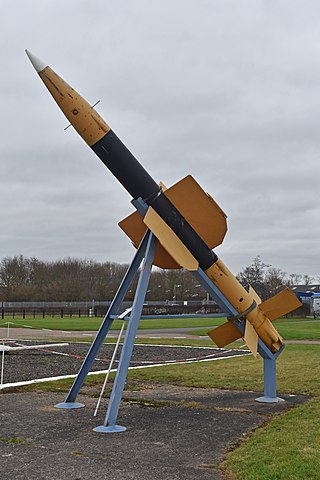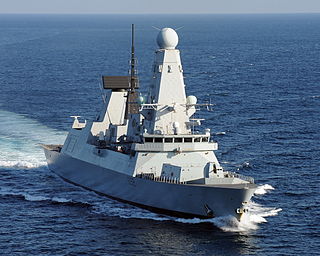
HMS Norfolk was a County-class destroyer of the Royal Navy. She was the fourth Group 2 and the last of the County-class built.

The Type 45 destroyer, also known as the D or Daring class, is a class of six guided-missile destroyers built for the United Kingdom's Royal Navy in the early 21st century. The class is primarily designed for anti-aircraft and anti-missile warfare and is built around the PAAMS air-defence system using the SAMPSON Active electronically scanned array (AESA) and the S1850M long-range radars. The first three destroyers were assembled by BAE Systems Surface Fleet Solutions from partially prefabricated "blocks" built at different shipyards; the remaining three were built by BAE Systems Maritime – Naval Ships. The first ship in the Daring class, HMS Daring, was launched on 1 February 2006 and commissioned on 23 July 2009.

The County class was a class of British guided missile destroyers, the first such warships built by the Royal Navy. Designed specifically around the Seaslug anti-aircraft missile system, the primary role of these ships was area air defence around the aircraft carrier task force in the nuclear-war environment.

HMS Fife was the first unit of the Batch 2 County-class destroyers of the Royal Navy. She was subsequently sold to Chile and scrapped in 2005.

HMS Glamorgan was a County-class destroyer of the Royal Navy with a displacement of 5,440 tonnes. The ship was built by Vickers-Armstrongs in Newcastle Upon Tyne and named after the Welsh county of Glamorgan.

HMS Hampshire was a County-class destroyer of the Royal Navy. Laid down, in March 1959 a couple of weeks behind the class leader Devonshire, she was classified as a guided missile destroyer, as the Sea Lords regarded the concept of the cruiser and big gun ship as discredited by the perceived failure of the Tiger class and the obsolescence of the heavy gun. The description of guided missile destroyer seemed more likely to win approval from the Treasury and Government for an adequate number of warships the size of small cruisers, which could play many traditional cruiser flagship and command functions, but had no armour around its gun and missile magazine.

HMS Kent was a batch-1 County-class destroyer of the Royal Navy. She and her sisters were equipped with the Sea Slug Mk-1 medium-range surface-to-air missile SAM system, along with the short-range Sea Cat SAM, two twin 4.5-inch gun turrets, two single 20mm cannon, ASW torpedo tubes, and a platform and hangar that allowed her to operate one Wessex helicopter. The County class were large ships, with good seakeeping abilities and long range, and were ideal blue-water ships for their time.

HMS London was a County-class destroyer of the Royal Navy.

HMS Bristol (D23) was a Type 82 destroyer, the only vessel of her class to be built for the Royal Navy. Bristol was intended to be the first of a class of large destroyers to escort the CVA-01 aircraft carriers projected to come into service in the early 1970s but the rest of the class and the CVA-01 carriers were cancelled as a result of the 1966 Defence White Paper which cut defence spending.

HMS Tiger was a conventional cruiser of the British Royal Navy, one of a three-ship class known as the Tiger class. Ordered during World War II, she was completed after its end.

HMS Lion was a Tiger-class light cruiser of the British Royal Navy, originally ordered in 1942 as one of the Minotaur class and laid down that same year as Defence by Scotts Shipbuilding and Engineering Company at Greenock in Scotland on 6 June 1942.
HMS Phoebe (F42) was a Leander-class frigate of the Royal Navy (RN). She was, like the rest of her class, named after a figure of mythology. Built by Alexander Stephen and Sons on the River Clyde, she was launched on 19 December 1964 and commissioned on 15 May 1966.

Sea Dart, or GWS.30 was a Royal Navy surface-to-air missile system designed in the 1960s and entering service in 1973. It was fitted to the Type 42 destroyers, Type 82 destroyer and Invincible-class aircraft carriers of the Royal Navy. Originally developed by Hawker Siddeley, the missile was built by British Aerospace after 1977. It was withdrawn from service in 2012.

Seaslug was a first-generation surface-to-air missile designed by Armstrong Whitworth for use by the Royal Navy. Tracing its history as far back as 1943's LOPGAP design, it came into operational service in 1961 and was still in use at the time of the Falklands War in 1982.

HMS Daring is the lead ship of the Type 45 or Daring-class air-defence destroyers built for the Royal Navy, and the seventh ship to hold that name. She was launched in 2006 on the Clyde and conducted contractor's sea trials during 2007 and 2008. She was handed over to the Royal Navy in December 2008, entered her base port of Portsmouth for the first time in January 2009 and was formally commissioned on 23 July 2009. As the lead ship of the first destroyer class built for the Royal Navy since the Type 42 in the 1970s, she has attracted significant media and public attention. Her name, crest and motto are a reference to the Roman youth Gaius Mucius Scaevola, famed for his bravery.

HMS Dauntless is the second ship of the Type 45 or Daring-class air-defence destroyers built for the British Royal Navy. She was launched at Govan in January 2007, was handed over to the Royal Navy on 3 December 2009 and was formally commissioned on 3 June 2010.

HMS Diamond is the third ship of the Type 45 or Daring-class air-defence destroyers built for the Royal Navy. She was launched in 2007, completed her contractor's sea trials in July 2010 and arrived at her base port on 22 September 2010. Diamond was commissioned in a traditional ceremony on 6 May 2011, and formally entered service on 12 July 2011.

HMS Defender is the fifth of the Type 45 or Daring-class air-defence destroyers built for the Royal Navy. She is the eighth ship to bear the name. Construction of Defender began in 2006, and she was launched in 2009. The ship completed her first sea trials in October and November 2011, and was commissioned during March 2013.

HMS Duncan is the sixth and last of the Type 45 or Daring-class air-defence destroyers built for the Royal Navy and launched in 2010. Duncan is named after Adam Duncan, 1st Viscount Duncan, who defeated the Dutch fleet at the Battle of Camperdown on 11 October 1797. The destroyer has served in the Mediterranean, Black, and Caribbean Seas, and in 2019 was deployed to the Persian Gulf in response to increased tensions with Iran in the region.

HMS Wakeful was a W-class destroyer of the Royal Navy launched in 1943. She saw service during the Second World War and was later converted into a Type 15 fast anti-submarine frigate. She was sold for scrap in 1971.




















